Keeping our training routine interesting and fun is key if we want to stay consistent and dedicated while constantly progressing forward and getting results.
That doesn’t mean we should mix up our workout every day or just throw together random moves. But it does mean progressing and introducing not only new movements, but also new training tools into our routine so that we avoid plateaus and challenge our bodies in new ways.
One great way to challenge your body and add some variety to your routine is by creating an unstable training environment. This can be done with unilateral loads or by using a balance board.
By forcing your body to work harder to stabilize during movements, you not only help build functional strength but you get all of those stabilizer muscles engaged and working. Plus, you can improve your mind-body connection for better coordination, stability AND strength!
If you’re looking for a new challenge and a great way to really improve not only your full-body strength, but also core stability, you should try adding in Balance Board exercises to your workout routine.
When I pick tools, I also like to make sure they are versatile enough that if I have only that SINGLE ITEM and my bodyweight, I can get in a variety of workouts. The balance board not only allows you to do that, BUT if you have the Revolution FIT, you can also use one of the rollers as a foam roller!
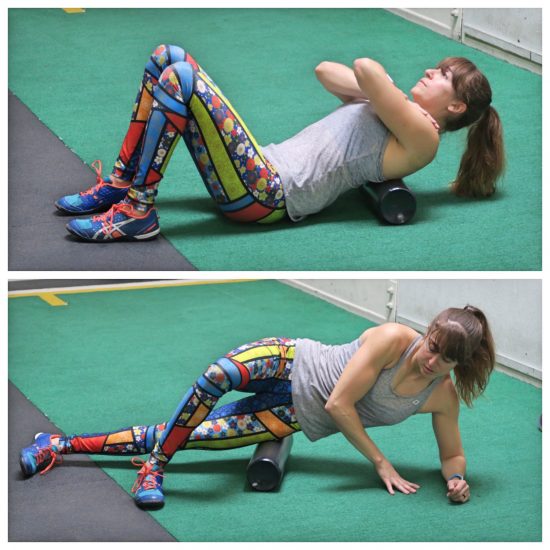
Love added bonuses like that! A workout and recovery kit all in one 😉
Below I’ll go over 16 Balance Board Exercises you can do. I’ll use the Revolution FIT Balance Board to show you how you can get in a great full-body workout with just this one tool!
16 Balance Board Exercises For A Balance Board Workout – Revolution FIT
Side to Side Forearm Plank (1:00):
Planks are an ESSENTIAL core move to include in your routine. And if you want to take them up a notch and really get your obliques working hard, you’ll want to try the Side to Side Forearm Plank on the Balance Board.
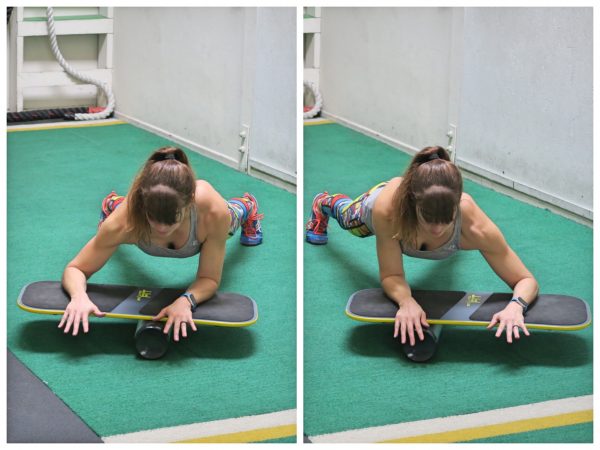
For this move, you’ll use the board and roller. Set up with your forearms on the board about shoulder-width apart and your feet wide. Draw your belly button in toward your spine and make sure your body is in a nice straight line. Engage your quads and glutes and make sure you aren’t shrugging.
Then slow roll the board over the roller to the right. Keep your core engaged as you shift your forearms to the side. Do not let your body rotate or butt go up in the air. Shift as far to one side as you can and then bring your forearms back under your body before shifting toward the other side.
Offset Push Up (1:12):
Push ups are a killer chest, shoulders, triceps and core move. But you can make them exponentially harder, but doing them on the board with your weight offset. Talk about a killer anti-rotational move that even isolates each side of your upper body by having your weight offset on the board!
Again using the board and roller, set up so the roller is under one side of the board and your hands are each on an edge. Set up with your feet about hip-width apart. A wider base with your feet will help with balance.
Start at the top of the push up with the board offset on the roller (aka under one side) and your body in a nice straight line from your head to your heels.
Then perform a push up without letting either side of the board touch the ground. Drop your chest as close to the board as possible with your body moving as one unit before pressing back up. Do not let your hips sag or butt go up in the air.
While this is a wider grip push up, do not let your elbows flare way up by your head and make sure not to shrug. Perform two push ups then roll the board across so that the roller is on the other side. Then perform to push ups focused on your other side!
Balance Push Ups (1:25):
If you’re looking to advance the basic push up, but not yet ready for the Offset variation, you should try the Balance Push Up. It is a great way to build core stability while strengthening your chest, shoulders and triceps!
Set up with the roller in the middle of the board and a hand on each edge of the board for a wider grip push up. Your feet should be about hip-width apart, but you can bring them closer together to create more instability, and your body should be in a nice straight from your head to your heels.
Start at the top of a push up and then lower your chest to the board without letting either side of the board touch the ground. Press back up and repeat. Do not let your hips sag or butt go up in the air. Do not tuck your chin. Keep your body in a nice straight line and make sure everything moves as one unit.
Beginners can also do this from their knees.
Forward Backward Rolls (1:33):
The Forward-Backward Rolls are another great way to advance the plank. And not only is this a great move to work your abs, glutes, quads and shoulder, but you can even use it to work your triceps and lats.
When you pull the roller back under after extending forward, focus on feeling your triceps and lats work to pull yourself back into that plank position!

Set up with the roller lengthwise under the board and your forearms on the board. Your elbows should start under your shoulders. Set your feet about hip-width apart with your body in a nice straight line and your abs engaged.
The slowly roll the board out in front of you. Extend forward as far as you can without your hips dropping or letting low back engaging. Then roll it back under, bringing your elbows back under your shoulders or even a little past. Feel your lats and triceps work to pull that board back under. You’ll also feel your abs engage so you don’t round or sag.
Repeat the roll back out and under. Move at a steady pace.
Single Leg Push Ups (1:40):
The balance board alone creates instability, forcing our body to work harder to stabilize as we move. But if you want to take things up even another notch, you can force your core to have to work harder to prevent rotation by making any movement a unilateral move.
By raising one leg as you do your push ups, you can force your core to work even harder to stabilize!
Set up on the board with the disc underneath. Place both hands on the board just outside your chest and raise one leg as you set up in a high plank position at the top of the push up.
Keeping any edge of the board from touching the ground, perform a push up, dropping your chest as close to the board as possible. Make sure your body moves as one unit. Do not let your hips sag or butt go up in the air. Also, do not let your elbows flare way up by your head. You do not want to shrug, but instead keep your back engaged to support your shoulders.
Press back up and repeat, keeping the leg lifted the entire time.
Balance Frogger (1:53):
The Frogger is a great core exercise and by doing it on the board, you can add in a little extra instability and make it a little more challenging.
Set the board on the disc and sit on top with your hands behind you on the ground. Turn your hands out to the side or have your fingers face toward your body. Extend your legs out straight in front of you as you lean back, bending your elbows.
Then straighten your arms as you sit up and tuck your knees in toward your body. Crunch everything together then open back up as you bend your elbows.
Repeat, moving quickly to crunch and extend.
Balance Lunge (2:01):
The balance board not only creates instability but it also allows us to increase the range of motion in which we can perform moves like the lunge.
When you place your front foot up on the board with the disc under it, you force your body to work hard to stay balanced and stabilize, but you also help yourself strengthen your legs through a bigger range of motion. This is why it is important that, when you add in the board, you still try to drop your back knee to the ground. If you don’t, you won’t be getting the full benefit of the extra few inches you could add to your range of motion!
We retain the flexibility we build with stretching when we strengthen through the full range of motion!
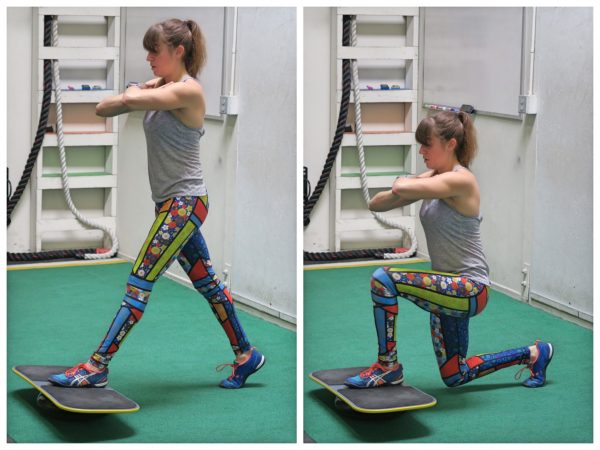
Set up in a lunge on the board with your front foot up and back foot back. Make sure your front foot is flat on the board as you stand tall. Without letting any edge of the board touch the ground, sink down into a deep lunge, trying to touch your back knee to the ground.
Keep your chest up as you sink and make sure your front knee stays basically aligned over your ankle. Feel yourself loading your front glute as you sink down. Then drive fully up to standing and repeat. Stay in this staggered stance until all reps are complete then switch sides.
Side Lunge (2:14):
Just like with the Balance Lunge, the Side Lunge done on the board can force your legs and core to work hard to stay balanced and stabilize. And this move is a great way to move and work in a different plane of motion to develop functional strength.
Set up on the board with the disc underneath. Stand to the side of the board. Place one foot on top and step the other one out to the side so you are in a wider stance.
Stand tall then sit down and back, bending the knee of the leg on the board. Push your butt back to load your glutes and really sit back in your heel. Keep the other leg straight as you sink into the side lunge. Do not round forward although you can lean slightly forward and hinge at the hips to help load your glutes. Keep both feet pointing straight ahead as you sink and then drive back up to standing.
Complete all reps before switching and placing the other foot up on the board.
Down, Across, Up (2:22):
This is a great move if you want to work your legs and even start to learn how to balance on the board better.

Set up on the board with the half roller underneath. Place one side of the board on the ground and step onto the board with your feet about shoulder-width apart. Stand tall then squat down. Try to sink to about parallel to the ground.
In this squat, press down on the board to make the raised side drop to the ground. Do not stand up or round over as you seesaw to the other side. Once the other side is down, stand up out of the squat. Then repeat, squatting back down before shifting back to the first side and standing up.
To make the move harder, move slower so you have to spend more time in the squat!
Squat Balance Hold (2:35):
Isometrics are a great way to build stability. They can also help you become more comfortable being uncomfortable, which is so key both mentally and physically for achieving results.
And you can now make the basic squat hold even more challenging by doing it on a balance board! Your legs and core will thank you for sure!
Set up on the board with your feet about hip-width to shoulder-width apart. You can use the half roller, disc or full roller for this. The half roller is a great place to start for beginners.
Standing tall without the board touching the ground, sink down into a squat. Do not round over as you squat down. Sink to about parallel and hold, trying to stay balanced on the board without any side touching down!
Plank Sit Thrus (2:42):
We move in every direction in everyday life. We twist, turn and pivot. Which is why it is so key that we do the same in our workouts. That is why I love the Sit Thru in all of its wonderful variations, including this one with added instability off of the balance board!
Set the board on top of the half roller and place your hands on each edge while you set up in the high plank position with your feet about shoulder-width apart and your body in a nice straight line from your head to your heels.
Without letting any edge of the board touch down, jump and rotate one leg under your body, twisting open toward one side. If you are rotating toward the right, you will jump your left foot under your body and your right foot back. You should end up in a side plank position with your lower body while your hands stay on the board.
Then jump back into plank and rotate the other way. Do not let your butt go up in the air or your hips sag as you jump and twist. Keep alternating sides. Beginners can step instead of jumping.
Mountain Climbers (2:53):
Mountain Climbers are a great cardio-core exercise. They work everything from your shoulders to your knees while getting your blood pumping. And by doing them off the balance board, you force your core, especially your abs and shoulders, to have to work even to stabilize.
Beginners can do this off the half roller, but to make it more challenging, place the board on the disc and your hands on the board under your shoulders. Set up in a nice high plank position from your hands and feet with our feet closer together.
Keeping your core tight, bring one knee in toward your chest. Feel your abs engaging to tuck your knee in. Do not let your butt go up in the air or your hips sag. Also, do not shrug or tuck your chin. You want a nice straight line from your head to your heels. Keep the board balanced and don’t let any side touch down.
Tuck your knee in then extend and bring the other knee in. You can change the tempo to make the move more strength or more cardio oriented!
Plank with Kicks (3:04):
Working your core to help you move better and feel better, means not only working your abs and your frontside, but also your backside. Your glutes are KEY to running faster, lifting more and preventing injury, which is why I love any core move that also activates and works them!
The Planks with Kicks is a great anti-rotational exercise to engage and activate those glutes.
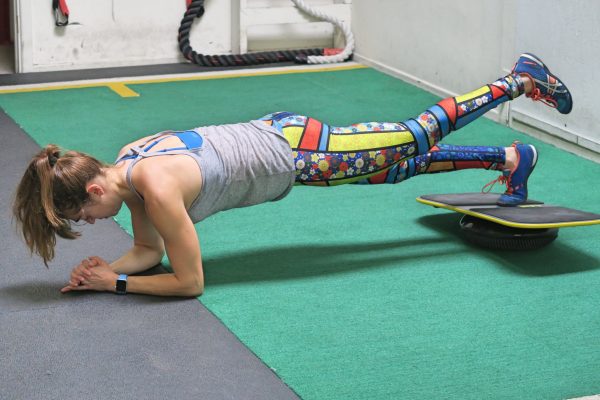
Set the board on the disc and place your feet up on the board on top of the disc. Your hands should be under your shoulders and your body should be in a nice high plank position. Brace your abs and engage your glutes as you slowly lift one leg up.
Do not swing the leg or hyperextend your leg to lift it up higher. Squeeze the glute and extend your hip to lift. Pause then lower and lift the other side. Move slowly and really focus on engaging the glute and not just lifting the leg as high as you can. Height doesn’t matter as much as extending the hip and activating the glute. If you feel your low back taking over, focus more on your abs and on using your glute to lift.
Push Up Rocks (3:20):
Push Up Rocks are a great way to isolate each side and make your body press in a more functional way (plus it is just so fun “seesawing” back and forth!).
As great as push ups are, often we aren’t pushing against even surfaces in every day life so one hand may be higher or we may be on a slight incline as we press. That is why it is great to practice pressing with other variables involved, like on the board.
But because this push up isn’t as unstable as some of the others, it can be a great one for beginners to even use, especially when done from their knees.
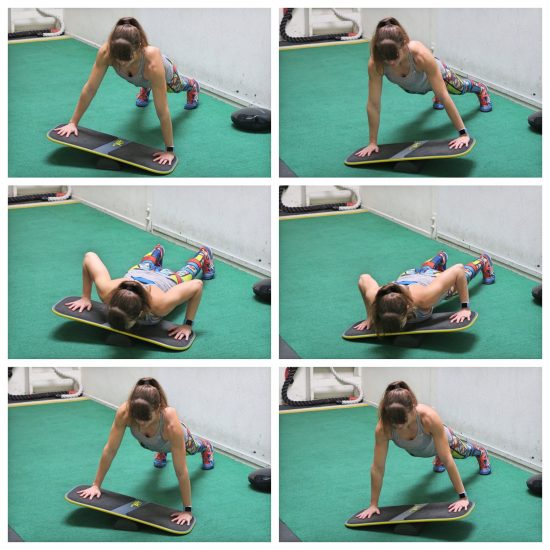
Set the board on the half roller with one side down and the other up. Place your hands just outside your chest on the board and set up in a high plank position. Place your feet about hip-width apart or even closer together.
Perform a push up with one hand on the raised side and one on the lower side. Press back up to the top then rock the board to the other side and perform a push up. Press back up and seesaw back before performing another push up.
Plank Jacks (3:35):
Plank Jacks are another great cardio-core move like the Mountain Climbers and using the board creates more instability so your core has to work harder.
Set up in with the roller under the board in a nice high plank position with your hands under your shoulders and feet together. Keeping the board from touching the ground, jump your feet out wide then back together.
Keep your core engaged and your hands under your shoulders as you jump your feet in and out. Do not let your butt go up in the air or your hips sag. Beginners can do this move by stepping instead of jumping.
Balance Burpees (3:40):
Burpees are the move we all love to hate. They are full body and very cardio. Using the board you can not only create more instability BUT also give yourself a light weight to press.
Set the board on top of the roller and grab the board on each side. Start in a high plank position. Then jump your feet in toward your hands, grab the board off the roller and stand up, pressing the board overhead.
After quickly pressing the board overhead, squat down and place the board back on the roller before jumping back out into the high plank position. You can add a push up here to advance the move or simply jump back in and repeat, pressing the board back overhead.
Start by moving slowly to make sure you balance in the high plank position after putting the board back down on the roller.
Using these 16 Balance Board Exercises you can get in a killer full-body workout! Which are your favorite moves!?
And if you now are so excited to try these moves and want the board I’m using, check out Revolution Balance Boards. I’m using their Revolution FIT and LOVE IT!
P.S. As you can tell from the photo…even Coconut was curious about the board 😉



